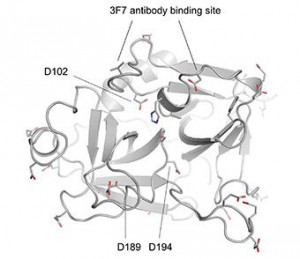August 3, 2015, by Editor
The School of Pharmacy Research Blog May-July 2015
Welcome to the Pharmacy School research blog which covers updates from our research activity including all the developments on advances in research and also publications and press releases in the pharmaceutical sciences
Caterpillar fungus could hold the key to relieving the pain of osteoarthritis
Dr Cornelia de Moor and her team have a three-year grant of £260,000 from Arthritis Research UK to investigate cordycepin as a new type of drug that has potential to relieve the symptoms of osteoarthritis, a common joint condition that affects more than eight million people in the UK. They will test the effectiveness of the compound, given as food pellets to rats and mice, to find out if cordycepin can prevent pain occurring after an injury to a joint, and also whether it relieves existing pain. Dr de Moor said that although their research was in its early stages they were excited about cordycepin’s prospects as a completely new type of painkiller. “When we first started investigating this compound it was frankly a bit of a long-shot and there was much scepticism from the scientific community,” she said. “But we were stunned by the response from the pilot study, which showed that it was as effective as conventional painkillers in rats.”To the best of our knowledge, cordycepin has never been tested as a lead compound for osteoarthritis pain.”
This research has also featured on BBC local television.
“This study is the first step in a potential drug development for a new class of drugs for osteoarthritis, although there are a number of hurdles we have to go through – necessarily so – before it gets nearer patients. To the best of our knowledge, cordycepin has never been tested as a lead compound for osteoarthritis pain.” Dr de Moor said that provided the safety and effectiveness of the compound could be proven, clinical trials could begin within six to ten years. This research has also featured on BBC local television.
Youtube video of EPSRC Rise leader Kevin Shakesheff on tissue engineering
RISE Leader Professor Kevin Shakesheff, Nottingham University and Rising Star Dr Marianne Ellis, University of Bath meet with Professor Jeremy Farrar, Director Wellcome Trust.
Kevin Shakesheff’s tissue engineering group also published a paper in Nature family journal Scientific Reports (2015) 5, 8577. This shows the ability to build and manipulate multicellular microscopic structures which will facilitate a more detailed understanding of cellular function in fields such as developmental and stem cell biology. A holographic optical tweezers based technology accurately generates bespoke cellular micro-architectures.
A second paper in Advanced Materials describes a dual thermoresponsive and magnetic colloidal gel matrix for enhanced stem-cell culture (Advanced Materials (2015) 27, 662-558)
Nature Structural and Molecular Biology publication in RNA biology.
Catherine Jopling has published an exciting study of micro-RNAs in the journal Nature structural and Molecular Biology (22, 319–327 (2015)) showing the mechanisms of how they contribute to the regulation of genes. This project was a collaboration with the group of Nick Proudfoot at Oxford University.
There was a recent article in The Guardian 04/02/2015 which highlighted a study which was published by Rachel Elliott in the Pharmaceutical Journal. This article showed that pharmacist intervention via the New Medicine Service (NMS) increases patient adherence in new medications by around 10%. Such awareness would lead to new approaches in compliance.
Structural Biology of the protease coagulation Factor XII resolved
P M Fischer, I Dreveny and J Emsley from the School of Pharmacy were authors on this paper.
The original model of the waterfall coagulation cascade describing how proteases regulate blood coagulation was published in 1964. Crystal structures have been important for understanding the molecular mechanisms underlying blood coagulation and to date crystal structures are available for all the coagulation protases except for factor XII (FXII) which lies at the top as initiator of the intrinsic pathway.
There has been a resurgence of interest in the FXII protease of late as knockout studies in mice reveals it is essential for formation of pathological thrombi is mouse mouse systems of cardiovascular disease and stroke. In addition there is a broad interest in FXII as it is involved not only in blood coagulation but also innate immunity and blood pressure regulation. In humans it has been shown to cause hereditary angiodema and has been linked to cardiovascular disease and alzheimers. FXII is clinically significant since over 200 million activated partial thromboplastin times (APTT), a routine screening test for bleeding disorders, are performed annually in United States requires its presence to be normal. Despite all this interest there was no structure for the FXII protease domain which is critical to observe the shape of the active site and understand mechanisms of zymogen activation, substrate recognition and inhibitor binding. For the first time the Emsley group at the University of Nottingham presents two crystal structures defining a zymogenic form of the FXII protease domain. This data describes the unique structural features of this important coagulation factor and provides a scaffold to develop novel anti-coagulants with a reduced bleeding side effect. (J. Thromb. Haemost. (2015) 13, 580-591)
Follow this link to the School of Pharmacy Journal, a collection of publications and press releases from May to July collated by Gail Atkinson.
Prof Jonas Emsley
jonas.emsley@nottingham.ac.uk
Chair of School Research Committee(Nottingham)
Dr Nashiru Billa
nashiru.billa@nottingham.edu.my
Chair of School Research Committee
(Malaysia)







Hi Julie;
May I say a very interesting article. I look forward to reading more about the clinical trials on cordycepin for osteoarthritis pain.
Regards
Dawn
Agree. Want to learn more about clinical trials on cordycepin for osteoarthritis pain.
Cordycepin, or 3′-deoxyadenosine, is a derivative of the nucleoside adenosine, differing from the latter by the absence of oxygen in the 3′ position of its ribose part. It was initially extracted from fungi of genus Cordyceps, but is now produced synthetically.
Cordycepin, or 3′-deoxyadenosine, is a derivative of the nucleoside adenosine, differing from the latter by the absence of oxygen in the 3′ position of its ribose part. It was initially extracted from fungi of genus Cordyceps, but is now produced synthetically.